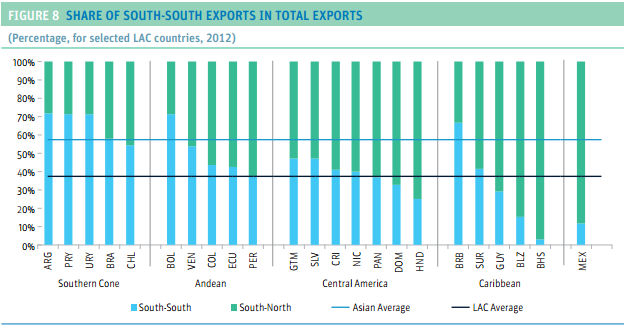South-South Trade and Latin America

More on:
The economic rise of the developing south is one of the biggest trends of the last decade, accelerated by the 2008 global economic downturn. Since 2001 trade between these countries has grown 18 percent a year on average, outpacing global trade growth of 11 percent. Nearly half of all exports worldwide now originate in emerging markets—predominantly Asia.
A recent Inter-American Development Bank report lays out how Latin America is faring with these global shifts. Overall the region has not kept pace. Trade flows have lagged GDP growth, up 1.1 percent and 3 percent respectively in 2012.
In part this reflects Latin America’s strong links to mature rather than developing economies—the United States and the European Union remain the region’s largest trading partners. Mexico, Latin America’s largest exporter by far, leads this trend, fully integrated with the United States (and to a lesser extent Canada). Central American and Caribbean countries generally follow, sending the majority of their exports north.

In contrast, many South American nations have made the shift, sending two-thirds or more of their exports to other emerging markets. For Brazil, Chile, and Venezuela, China is already their largest export destination, and according to the Economic Commission for Latin America and the Caribbean, the Middle Kingdom will edge out the European Union as the region’s number two trading partner by the end of the decade. Yet this growing dependence has been double-edged more recently, as China’s growth slows.
Still, bright spots exist for Latin America. Exports to their neighbors are robust, accounting for more than half of total South-South trade. Intra-industry trade is an important component, and more likely to involve intermediary and manufactured goods. Economists show that these exchanges are more likely to bring benefits in terms of productivity, competitiveness, and innovation. And there are still advantages to Latin America’s geographic and historical trade flows with the United States: these exports are more diverse and provide more value added than those with China.
As Latin American nations diversify their export destinations, the challenge will be to do the same with their products. While still far from building the robust supply chains that dominate Asia, growing intra-industry trade in the region hints at the possibility that in some industries and sectors an actual “Latin American factory” could emerge.
More on:
 Online Store
Online Store
